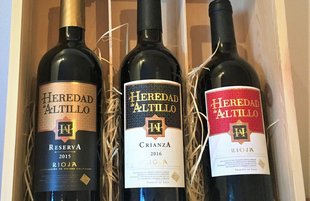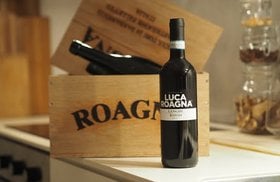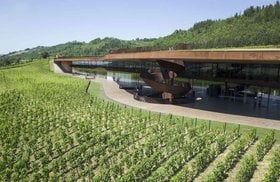Rioja Wine: Winemaking, Best Bottles, Prices (2025)
What makes Rioja wine so unique, and which bottles should you buy?
Rioja wines have excellent aging potential and a structure as elegant as the finest from Burgundy and Bordeaux.
Following a slump in quality in the 1900s, the region turned itself around in the 2000s with innovative winemaking techniques and significant investments. Today, these red wines represent fantastic value, especially when you compare them to the French counterparts.
The Rioja wine region also has very specific wine aging requirements, which are strictly regulated by the DOCa Rioja board.
Let’s go on a wine tour around the region and discover everything about this Spanish wine, the various wine styles, and the best wines you should look out for in 2024.
You’ll also discover a hassle-free way to invest in a bottle or two of great wine!
Further reading
- Find out all about Wine Investing in this detailed guide with insider tips, and more.
- Also check out these delicious Chablis wines and these luscious Bordeaux bottles.
What is Rioja Wine?
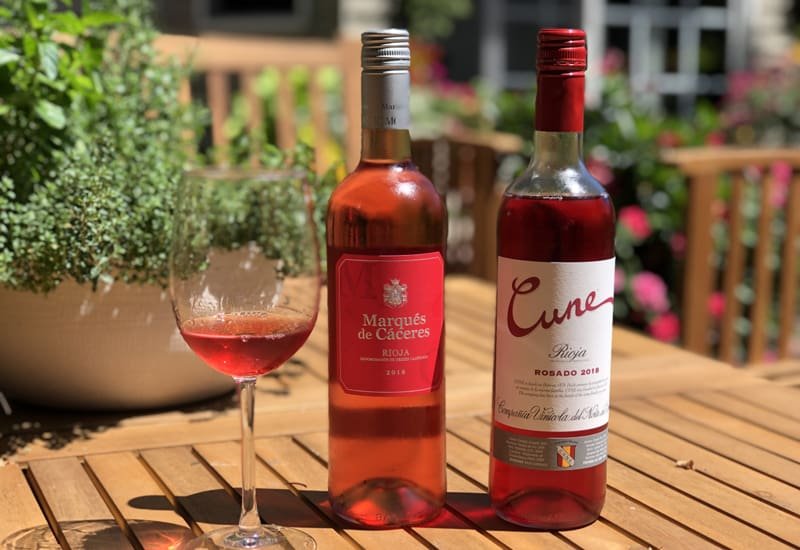
Rioja is located in Northern Spain, next to the Iberian Peninsula, where the Tempranillo grape has been growing for centuries.
The vineyards of the Rioja wine region span 60 miles across the Ebro River between the towns Haro and Alfaro.
The Rioja appellation produces many exceptional red, white, rose, and sparkling wines, of which the reds are the most sought-after.
The red blends made from the Tempranillo and the Garnacha (Grenache) grape varieties are the most popular wines from the La Rioja wine region.
The Rioja wines have a robust structure, tannins, and fruitiness similar to Cabernet Sauvignon. The wines also have some Pinot Noir qualities evident in the grape’s cherry flavors.
Fun Fact: Marqués de Riscal, a famous Rioja producer, was among the first wineries to plant the Cabernet Sauvignon grape variety in Rioja and create a unique Cabernet Sauvignon-Tempranillo blend.
Rioja is also big on wine tourism - an ideal destination for food and wine lovers!
Next, let’s dive into the history of Rioja wine!
A Glimpse into the History of Rioja Wine
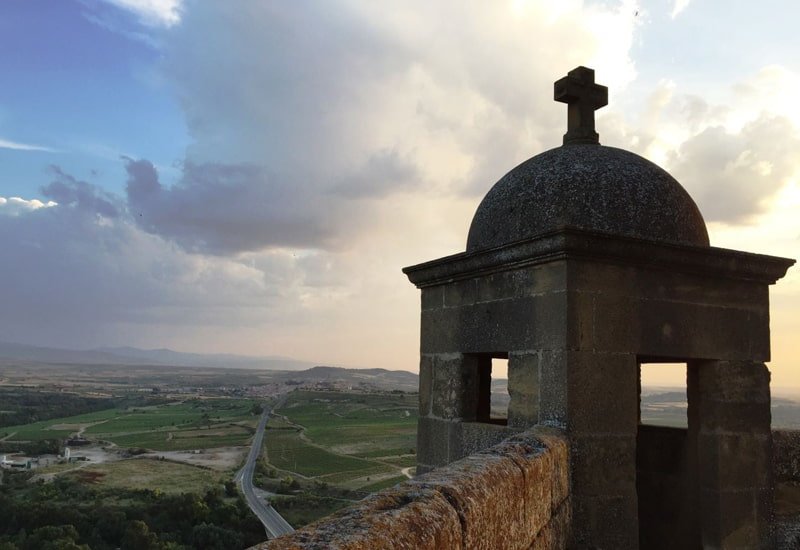
Vine growing and winemaking in the Rioja appellation dates back to the Roman times. Wine production thrived between 200 BC and 6th century AD.
The Rioja region commercialized winemaking during the 1200s.
During the 1780s, Don Manuel Quintano brought the first oak barrel aging techniques from Bordeaux in France to northern Spain. In 1787, the Real Junta de Cosecheros (Royal Board of Winegrowers) was created to advance grape growing and wine quality in the Rioja wine region.
Between 1806 and 1899, seasoned winemakers introduced new wineries, winemaking processes, and aging techniques.
At the start of the 20th century, the phylloxera fungus devastated the vineyards and put the wine region into decline. It was only in the 1970s that the industry revived after French investment poured in and winemaking was modernized.
In 1925, Rioja was the first Spanish wine region to obtain Designation of Origin (DO) status and, in 1991, advanced to DOCa (Denominación de Origen Calificada).
The 1970 vintage cemented Rioja’s title as one of the best Spanish wines in the world.
Today, Rioja has a strong wine culture and is a hub for wine tourism - just like the neighboring Basque Country.
Fun Fact: In 1637, the mayor of Logrono was concerned that vibrations from carts could cause the quality of wine to deteriorate. So only pedestrians were allowed on the streets near the wine cellar rooms.
Sub-Regions of The Rioja Wine Region
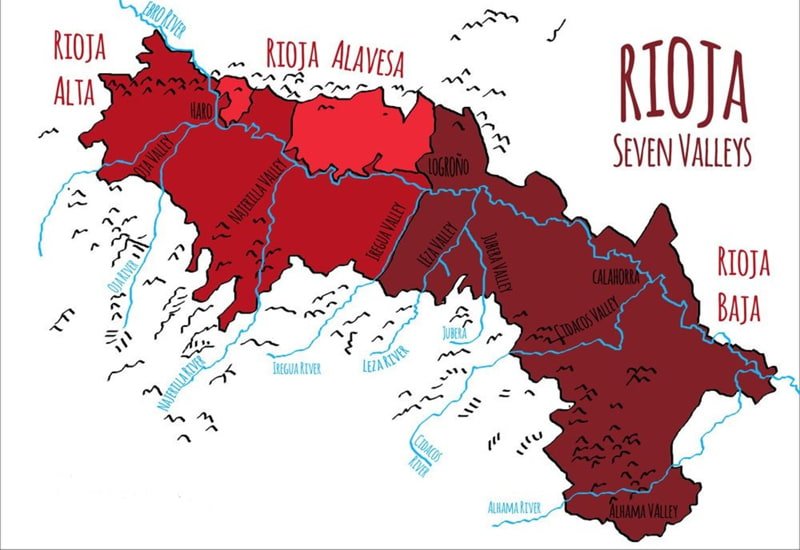
The vineyards in the Rioja wine region span across the La Rioja administrative area, upto 120 miles south of Bilbao. These vineyards span 63,593 hectares across three sub-regions.
Let’s take a quick look at them:
- Rioja Alta: The Rioja Alta vineyard lands are in western Rioja and are known for their ‘old world’ wine style. This sub-region is influenced by the cool Atlantic climate and has a high elevation, so the vine growing season is shorter. The La Rioja Alta soils have clay, iron, and alluvial elements with some limestone deposits.
- Rioja Alavesa: These vineyard plots are next to the Rioja Alta subregion in the Alava province of the Basque Country. The terroir consists of steep slopes and chalky clay-limestone soils with fewer nutrients.
- Rioja Oriental (Previously Rioja Baja): Rioja Oriental has a Mediterranean type climate making it the driest and warmest area in Rioja. This is perfect for growing the Garnacha grape variety. The Rioja Orientalsoil is chalky and fertile with heavy silt and stone remains from ancient floods.
Now let’s explore the different grapes that go into making Rioja wine.
The Grapes of Rioja

Rioja produces wine blends and some excellent single varietal Tempranillo wines. The wines that fall under the DOCa Rioja status are made from grapes grown in the subregions of La Rioja, Pais Vasco, and Navarre.
These are the most used red grapes in the Rioja wine region:
- Tempranillo
- Graciano
- Mazuelo (Carignan)
- Maturana Tinta
- Viura (Macabeo)
- Garnacha Tinta
- Malvasía
- Chardonnay
- Maturana Blanca
The acreage of white Rioja grape varieties is much lesser than the red grapes. The main ones are:
- Viura (Macabeo)
- Malvasía
- Garnacha Blanca
- Sauvignon Blanc
Rioja Wine Styles and Winemaking

Rioja’s annual wine production is about 300 million liters. Out of this, 90% is red wine, and the remaining 10% is a mix of white and rose wines.
Different Rioja wine styles follow different winemaking processes:
- Red wine: The grapes can either be destemmed before fermentation or go directly through carbonic maceration (fermentation of whole bunches with the stems.)
After carbonic maceration, the red Rioja wines are aged in 225-liter oak barrels for 1-3 years, followed by six months to six years in the bottle. A mix of American oak and French oak barrels are used to age the red wines. American oak barrels lend characteristic notes of vanilla, coconut, and sweet spice to these Rioja wines.
However, modern Rioja wine is smoother and less acidic, thanks to the use of Hungarian oak and French oak barrels.
- White wine: White Rioja wines mainly contain the Viura (Macabeo) grape along with other grape varieties. The grapes are drained and only the grape juice is fermented.
- Pink wine: Rose wines are usually made with the Garnacha grape to give them a distinct fruity flavor.
The winemakers de-stem and press the grapes slowly. The liquid is macerated with the skins and then decanted before fermentation.
- Other wine styles: Rioja produces sparkling wine like Cava as well as dessert wine.
Fun Fact: Unknown to many, Rioja wine has played a role in the creation of the popular drink, Sangria. The cocktail grew popular globally after the winery Bodegas Rioja Santiago showcased a Sangria made with Rioja wine at the 1964 World’s Fair.
Let’s move on to the aging classification for Rioja wine.
Rioja Wine Aging Classification
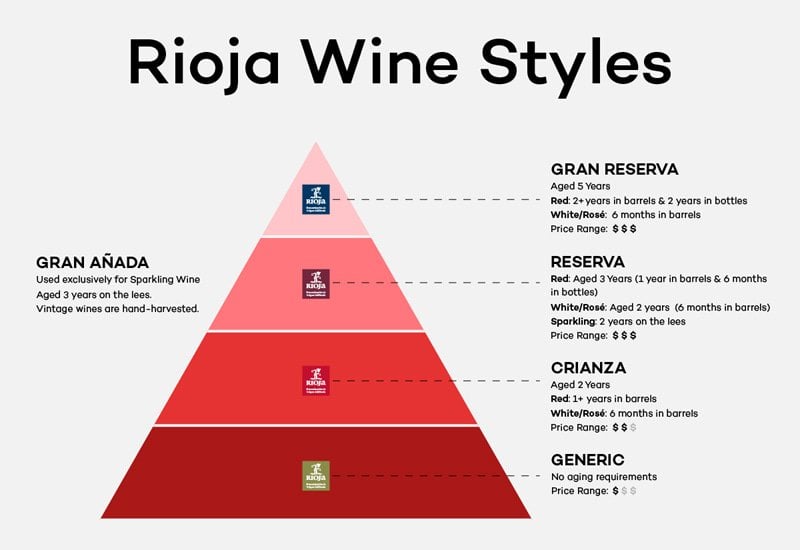
The Consejo Regulador DOCa Rioja acts as the wine control board in the Rioja region. They ensure every winery maintains consistent wine quality.
How is the Rioja aging classification determined?
It depends on how long the Rioja wine spends in the barrel (and bottle, in some instances).
These are the classifications and their characteristics:
- Rioja / Generico: This was previously called ‘vin joven’ (translates to ‘young wine’). A Rioja label guarantees only the wine’s origin and vintage. Nearly 40% of Rioja wines are of this category.
- Crianza: Wines under the Crianza category spend one to three years in an oak barrel, followed by a few more months in the bottle. White and rose wines must spend a minimum of 6 months in the barrel to be labeled as Crianza.
- Reserva: The Reserva wines are made with grapes from good growing seasons. Winemakers must age Reserva wines beyond the minimum requirement. Red wines age for at least three years and a minimum of one year in the barrel. White and rose Reserva wines are required to age for a minimum of two years, with six months in the barrel.
- Gran Reserva: Wines classified as Gran Reservas are made with the highest-quality grapes from the most exceptional vintages. Gran Reservas go through a prolonged oak aging process, spending at least two years in the barrel and two more in the bottle. Only 2% of Rioja wines are labeled as Gran Reserva.
- New Site-Based Classification: The Consejo Regulador (governing body) introduced three new geographical categories in 2017 - Viñedo Singular, Vino Municipio, and Vinos de Zona. This allows wine producers to label their wines after the vineyard, municipal area, or the subregion where the grapes are grown.
Now let’s see if Rioja wines are worth investing in for the long term.
Is Rioja a Good Investment Wine?
While Rioja has great young wines, it is known for wines with good aging potential. Some of them can age beautifully for up to 30 years, depending on the wine’s aging classification. The Gran Reservas and Reservas have the greatest aging potential.
To determine if a Rioja has the potential to develop in flavor with time, consider where the wine is made and how much time it was aged in oak.
Besides, the prices of some high-quality Rioja wines have been on the rise due to great scores from critics like Robert Parker, longevity, low production volumes, and improved quality standards from new boutique wineries with a “cult” status.
- For example, the 2004 Artadi Vina El Pison, Alava, Spain, was awarded 100 points by Robert Parker. After this, the wine’s price shot to about $250 per bottle.
- Robert Parker also awarded 100 points to the 2004 and 2005 vintages of Bodegas Contador - Benjamin Romeo 'Contador', Rioja DOCa, Spain. These expressive wines are of exceptional quality and fetch about $320 each.
Premium Rioja wine has plenty of potential and is ideal for the more modern collector.
8 Prestigious Rioja Wines to Buy in 2024 (Including Taste, Prices)
We’ve selected some of the best Rioja wines that you cannot miss!
1. 2016 Sierra Cantabria 'Magico' Rioja DOCa, Spain
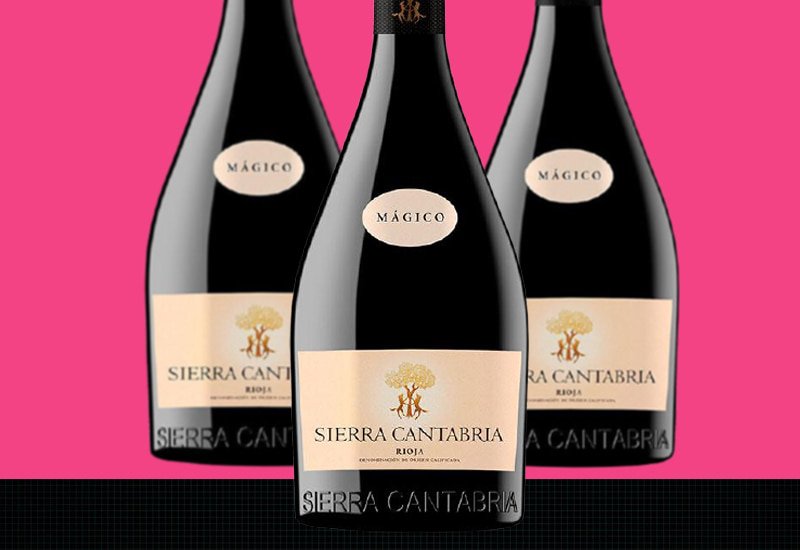
This Rioja red blend has a clean and bright hue and an intense fruit flavor. It has an expressive nose with licorice and red fruit notes. On the palate, this Spanish wine has floral elements along with notes of yeast and oak.
Price of 2016 Sierra Cantabria 'Magico' Rioja DOCa, Spain: $537
2. 1981 R. Lopez de Heredia Vina Tondonia Gran Reserva Blanco, Rioja DOCa, Spain
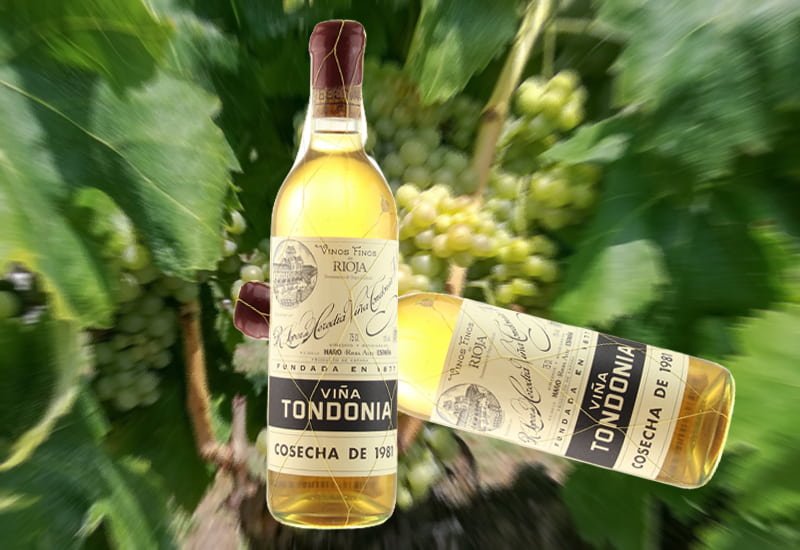
Here we have a medium-bodied white wine with a complex nose of dandelion, barley, lemon, and hints of green olive notes. On the palate are dried honey and lemongrass flavors. This white Rioja has firm acidity and a long finish.
Price of 1981 R. Lopez de Heredia Vina Tondonia Gran Reserva Blanco, Rioja DOCa, Spain: $360
3. 2015 Alvaro Palacios Quinon de Valmira, Rioja DOCa, Spain

This delicious Garnacha Tinta wine has an incredible nose of fruit, flowers, and wild herb notes. It has good depth, a lovely mouthfeel, and fine tannins.
Price of 2015 Alvaro Palacios Quinon de Valmira, Rioja DOCa, Spain: $444
4. 2017 Bodegas Contador - Benjamin Romeo 'Contador', Rioja DOCa, Spain

Here’s a flavorful young wine with aromas of lilies, red cherries, and black fruit flavors. The palate has tasting notes of creamy and sugary elements with an elegant tannin mouthfeel. This modern Rioja wine goes well with lamb, roasted pork, and chorizo.
Price of 2017 Bodegas Contador - Benjamin Romeo 'Contador', Rioja DOCa, Spain: $311
5. 2015 Bodega Lanzaga 'Las Beatas', Rioja DOCa, Spain
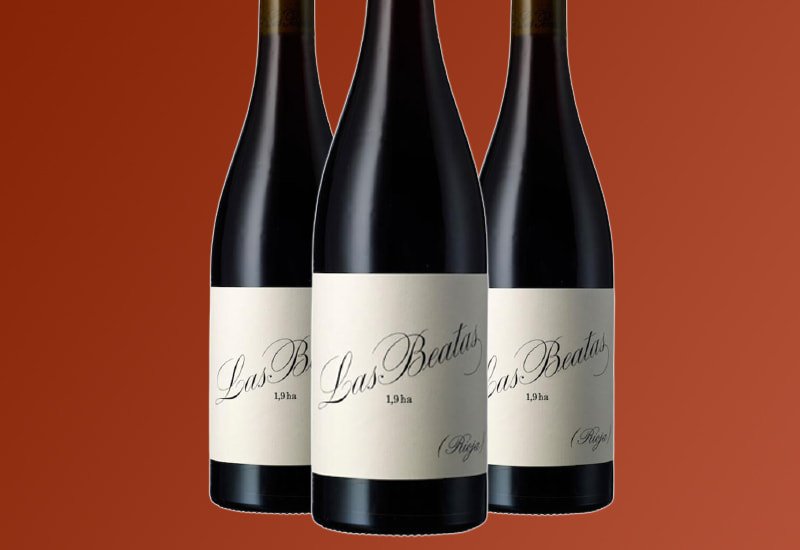
This rare red blend has ripe fruit flavor, chalky tannins, great depth, and balance. Its aroma expands slowly with a lovely delicacy. Pair this wine with chorizo and bold cheeses.
Price of 2015 Bodega Lanzaga 'Las Beatas', Rioja DOCa, Spain: $494
6. 2015 Bodegas Roda Cirsion, Rioja DOCa, Spain
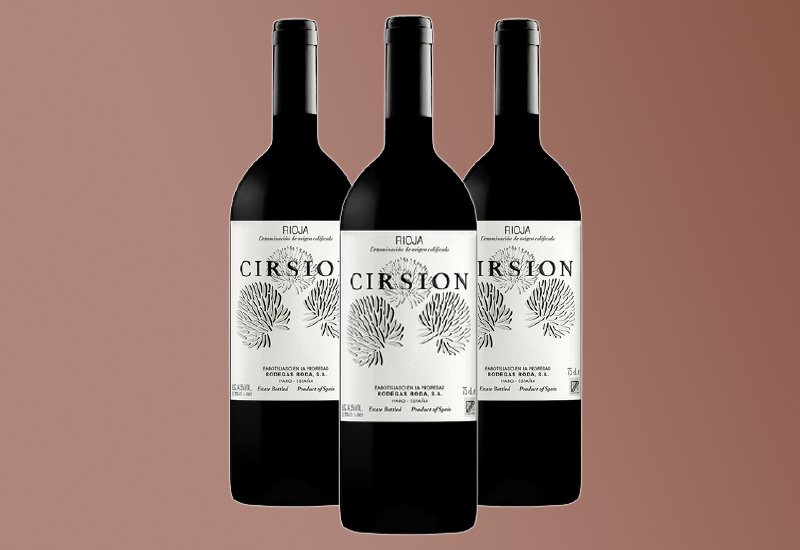
This voluptuous, spicy red wine has aromas of ripe fruit along with hints of chocolate and balsamic vinegar. On the palate are tasting notes of deep mocha and cocoa, and sweet fruit. This silky wine has a ripe tannin texture, excellent structure, and minerality.
Price of 2015 Bodegas Roda Cirsion, Rioja DOCa, Spain: $242
7. 1952 Marques de Murrieta Castillo Ygay Gran Reserva Especial, Rioja DOCa, Spain
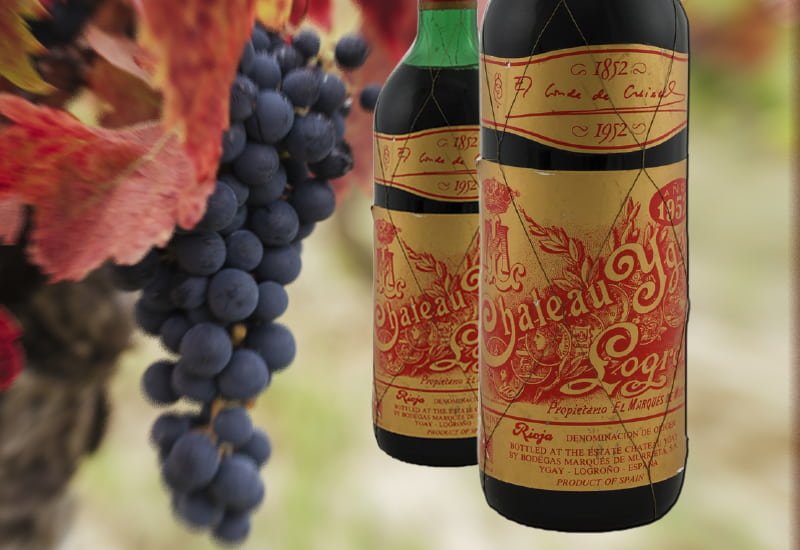
Here we have a delectable wine from an iconic Rioja producer. It has chocolate, ripe fruit, and vanilla flavors, and a robust, fresh texture.
Price of 1952 Marques de Murrieta Castillo Ygay Gran Reserva Especial, Rioja DOCa, Spain: $1,105
8. 1959 CVNE Vina Real Reserva Especial, Rioja DOCa, Spain

This Reserva wine presents aromas of leather, chocolate, cassis, and tobacco. On the palate are notes of citrus, ripe fruit, accompanied by a silky texture and great length.
Price of 1959 CVNE Vina Real Reserva Especial, Rioja DOCa, Spain: $523
Sourcing a bottle of Rioja wine may seem easy. But, if you’re looking for the sought-after Gran Reservas and Reservas you need to do your market research besides making long-term storage arrangements.
However, with an investing platform like Vinovest, procuring your own Rioja wine or any other investment-grade wine would be super-easy.
Here’s how:
Buy Rioja and Other Wines Easily Through Vinovest

Vinovest is a wine investment company that allows you to buy, sell, store, and deliver wines with just a few clicks.
How does it work?
All it takes is four easy steps to get started:
- Sign up with your name, email address, and password on the Vinovest platform.
- Fill out a form about your investment preferences and risk appetite.
- Add a minimum of $1,000 to your account.
- Allow Vinovest to curate your collection of wines while you sip on a delicious Malbec!
What are the benefits?
Vinovest offers these fantastic benefits:
1. Unbeatable Prices
Vinovest offers excellent prices as they directly source all wines from the industry’s best winemakers and wine merchants.
2. Easy Buying and Selling
Vinovest’s AI platform allows you to buy and sell your wines with just a few simple clicks.
3. Low fees
Vinovest charges lower fees than most other wine investment firms. You only pay a 2.5% yearly fee (1.9% for a portfolio exceeding $50,000). This amount includes buying and selling wines, storage, insurance, wine fraud detection, and portfolio management.
4. Authenticity and Provenance
Vinovest traces your wine’s provenance to ensure its authenticity, so you will never have to worry about receiving counterfeit wines ever again.
5. Curated Portfolio
Vinovest’s team of professional sommeliers and data scientists will do all the hard research and number crunching for you. So, you can build a winning wine portfolio of wines in no time.
6. Excellent Storage
Don’t want to invest in a modern wine cellar?
Vinovest will take care of all your wine bottles and store them in bonded warehouses under optimal conditions (light, humidity, temperature, and vibration.)
7. Global Network
Vinovest gives you access to upcoming vineyards, limited vintage releases, and private wine company sales. You can also join the wine tasting events with renowned winemakers.
8. Easy Delivery
Vinovest will deliver your bottle of wine anywhere you want.
Buy a Rioja Wine Worthy Of Your Collection
Some high-quality Rioja wines are compared to the finest from Bordeaux and Burgundy. They’re long-lived with irresistible flavors.
And the smartest way to add an exquisite wine from the Rioja wine region or any other part of the globe to your collection, is through Vinovest.
So wait no more!Sign up and start building your wine collection right away.
